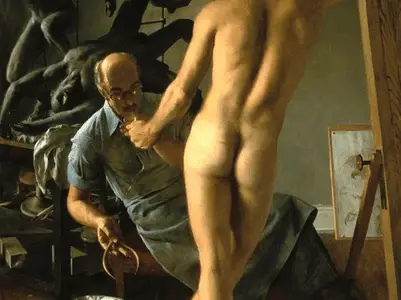
John Koch – The Sculptor, 1964, The original title was “Prometheus”, changed by the artist himself to “The Sculptor”, Brooklyn Museum.
A deliciously lit sensuous full-length male nude dominates this sexually pulsating homoerotic painting by John Koch, an American painter in the realist style.
The often-used model, Ernest Ulmer, casually leans against an easel or a full-length mirror with his hand on the top. His legs cross at the calf’s, he is comfortable with his nudity and his nonchalant stance shows it. The slight line running around the buttocks teasingly suggests a possible scant covering of genitals for a modicum of modesty. The sculptor (Koch himself) slants awkwardly and leans in to get a light for his cigarette. The flame is reflected in both lenses of his glasses. An unseen light source from the left highlights the top of his head, his resting arm, and callipers. The sculptor holds a pair of callipers used for measuring. Below the callipers we see a wicker waste basket lined or filled with paper.
In the background is a sculpture in progress surrounded by the paraphernalia of a sculptor’s tools and equipment. It is dimly lit dark and foreboding, partly in shadow and partly seen in silhouette with some highlights. On the right-hand side, half seen and obscured by the wood frame we see a sepia drawing pinned to a board, a study of eagles.
The sculpture in progress depicts the Greek legend of Prometheus, a Titan, not a god, who, defied the god Zeus and stole fire from Mount Olympus for the benefit of Mankind. Prometheus was a champion of humankind and is credited with giving arts and science to the world (a fitting subject for an artist playing precariously with his reputation) A horrible punishment was inflicted on Prometheus for his defiance. Prometheus is chained to a rock, and daily an eagle tears at his flesh to eat his Liver. Prometheus was immortal, his liver would regenerate for the torture to repeat, time and time again. Eventually, Prometheus revealed a secret to Zeus to gain an end to his relentless torture and Hercules, sent by Zeus, killed the bird.
Prometheus and fire and the artist taking a light from his model may be a mild pun or a deeper understanding and reference to guilt or acknowledgement of the dangers of his own homosexual leanings. The references are not exactly subtle to contemporary eyes. Ulmer’s dominance and relished sexuality contrast with Koch’s awkwardness and subservient posture. The hand and arm that holds the artist’s cigarette fall provocatively in line with the model’s groin, the gesture of the cigarette, and the callipers a symbol of measuring size, pinching and gripping are also provocative references.
Although this painting and others of his oeuvre pulsate with latent homosexual references from the characters in his paintings, there is little to suggest that Koch himself had bisexual or homoerotic tendencies.
“The posthumously published journals of Leo Lerman (1914-1994), a friend of Koch’s and a subject in several paintings, made reference to the artist as a homosexual, but there is no other literature or stories from his many friends and students that corroborate this, and he was happily married, for almost 50 years, to Dora Zaslasky.”




















